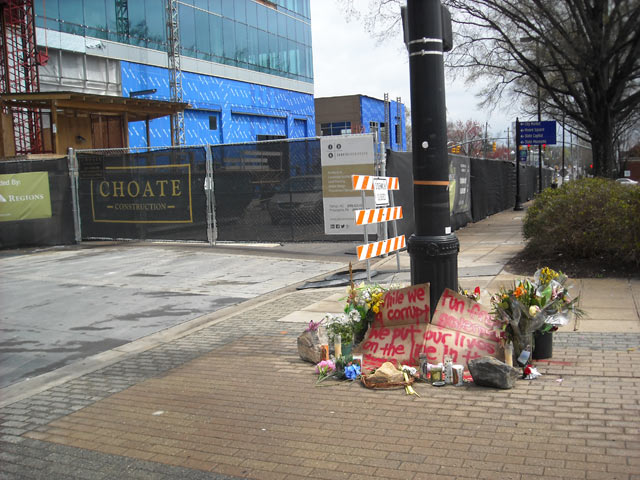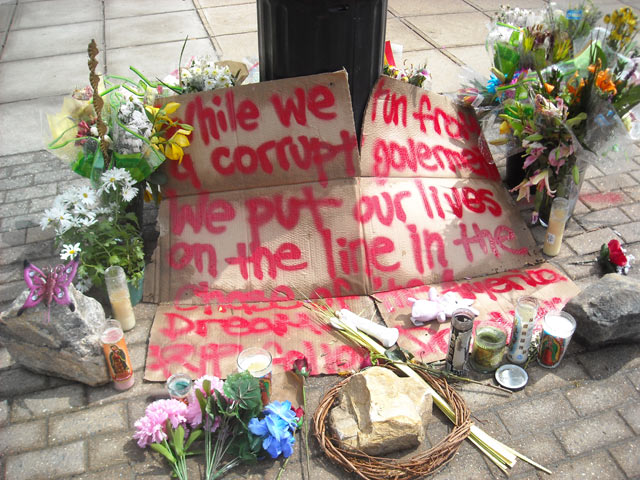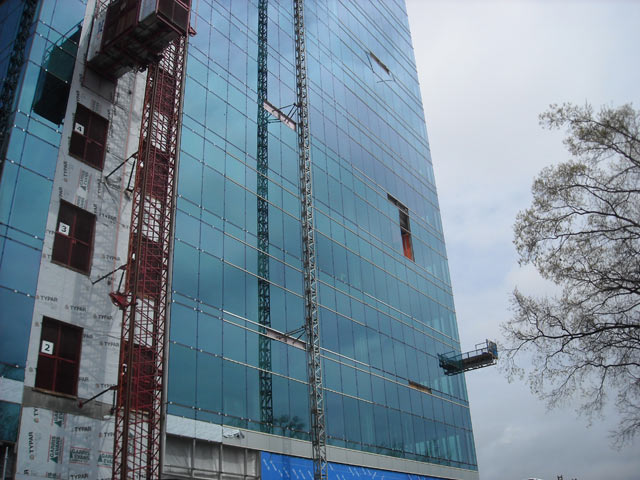
Monday morning, March 23, 2015, in Raleigh, North Carolina, was a mild and slightly overcast day. The first signs of spring were beginning to emerge after an uncharacteristically chilly winter for the capital of the Southern state. But the recent cold weather had hardly hampered the construction of several high-rise office and condo projects, unprecedented for the generally low-rise city.
The 12-story Charter Square was one such project, and on March 23, just before 11 am, workers were busy on its south wall, with two mast climbers attached to its all-glass surface. Mast climbers are a scaffolding device employing a thin, central steel column stuck to the side of a structure, along which a horizontal platform that ferries workers up and down, so that they can install the glass panels future occupants will gaze from when the building is finished. On this day, the mast climbers were to be dismantled, with the building scheduled for opening in May.
About halfway up, the mast suddenly peeled off the side of the building, sending José Erasmo Hernández, José Luis López Ramírez and Anderson Antones de Almeida to their deaths, and Elmer Guevara to the hospital in serious condition. The four men were working for a tangled web of contractors and subcontractors, and the Department of Labor’s representative on the scene said that contractors themselves inspect mast climbers, which are not specifically regulated by the state.
North Carolina Occupational Safety and Health’s Kevin Beauregard indicated that OSHA, the federal agency, also does not have specific guidelines regarding mast climbers. He added that he did not expect to find that the scaffolding had been previously inspected. “There’s no possible way our inspectors can go to every site,” Beauregard said. “We have over 200,000 work sites in North Carolina. We have approximately 75 to 100 inspectors employed. So it’s physically not possible to go to every single site.”
 (Photo: Danica Jorden)
(Photo: Danica Jorden)
2014 was the North Carolina construction industry’s most deadly year, according to data from the state Department of Labor. Nineteen people lost their lives working in construction in 2014, or 43 percent of the 44 work-related deaths statewide. Falls accounted for 13 of those deaths. The death rate was nearly double that of 2013.
According to the Bureau of Labor Statistics, Latinos are overrepresented in the construction industry, holding 24 percent of all construction jobs. But visits to construction sites in North Carolina reveal that Latinos are far more present at the front lines: scaling walls, down in holes and operating dangerous equipment. A closer look at the statistics shows that Latinos make up only 14 percent of first-line supervisors and 9 percent of managerial positions. Furthermore, BLS statistics show that from 2010 to 2013, fatalities for Latino construction workers rose 20 percent, while during the same period, deaths for non-Latinos fell.
In 2013, the AFL-CIO published a report on Latinos in the construction industry in New York. “A disproportionate number of Latinos and immigrants are disproportionately killed in fall accidents in New York, according to a new study by the Center for Popular Democracy, because they work in construction in relatively high numbers; are concentrated in smaller, nonunion firms; and are over-represented in the contingent labor pool,” according to the report.
 Facade of Charter Square, showing where the mast climber detached from the glass. (Photo: Danica Jorden)
Facade of Charter Square, showing where the mast climber detached from the glass. (Photo: Danica Jorden)
In New York, skyscrapers have been around for more than a century, and laws were written to regulate the construction industry and protect workers high up in the sky. The longstanding Scaffold Law was enacted in 1885, but is recently under attack. Construction companies have been working hard to amend it, saying it is one-sided in not protecting the industry from workers’ own negligence. According to a 2013 New York Times article:
They argue that the law is antiquated and prejudicial against contractors and property owners, and essentially absolves employees of responsibility for their own accidents, leading to huge settlements. The payouts, they contend, have in turn led to skyrocketing insurance premiums that are hampering construction and the state’s economic growth.
But also in 2013, industry publication Durability + Design conversely reported that the industry had just been successful in reducing its penalties regarding a significant 2009 mast climber accident that resulted in fatalities.
Nearly five years after three EIFS applicators fell to their deaths from a high-rise construction site in Austin, TX, a judge has ordered the scaffolding company in charge to pay $17,150 in fines. Mast Climber Manufacturing Inc. d/b/a American Mast Climbers, of Whitney, TX, contested the 2009 citations (eight serious, one willful) issued for safety hazards after the accident. The penalties originally totaled $86,800. In the Jan. 29 ruling, Administrative Law Judge Ken S. Welch affirmed the willful violation and two serious violations involving lift equipment set up at the site. The parties agreed to settle three serious violations, and the judge vacated the rest.
In right-to-work North Carolina, people in general have more limited recourse in the workplace and the courts, and immigrants may be at a distinct disadvantage when asserting their rights. A 2012 study entitled “Employer provision of personal protective equipment [PPE] to Latino workers in North Carolina residential construction” states its “results suggest that the residential construction subsector generally fails to provide [Latino] workers with PPE at no cost, as is required by regulation.”
Working side by side on a narrow platform high above the street on March 23, the men who lost their lives and their injured companion worked for at least three different companies. Brazilian Anderson Almeida and Elmer Guevara from El Salvador worked for Associated Scaffolding and Equipment, while José Hernández of Honduras and José Luís López from Mexico worked for Juba Aluminum/ Janna Walls and Kea Contracting. These subcontractors were employed by the site’s general contractor, Choate Construction. The property is owned by Dominion Realty.
According to the Southern Poverty Law Center (SPLC), using multiple subcontractors is a way to hide worker abuse as well as shield companies from culpability.
[W]orkers who try to stand up for their rights often find themselves frustrated by multiple layers of subcontractors and middlemen – an arrangement that seems designed to insulate corporations at the top from accountability for the mistreatment of workers. The same phenomenon was seen repeatedly in New Orleans with contractors working to clean up the city after Hurricane Katrina.
In a federal ruling, the SPLC won a case against Del Monte on behalf of agricultural workers, successfully arguing that “… the labor contractor and the workers were really employees of the Del Monte subsidiary and that the company was indeed responsible for any wage abuses that could be proven. The federal ruling was an important milestone for workers, but the fact remains that most Latino farmworkers in the South have little or no access to legal representation.”
Speaking to television news station Notícias 40 in Durham, Olvia López tearfully explained that her husband José Luís, father of their three children, had expressed fear about the conditions at his job, but felt he had no choice but to go to work. The station also indicated that José Hernández leaves behind a wife and two young children who depend upon him in Honduras, where he had intended to return in November, while Anderson Almeida had a partner, child and stepchild. The family of Elmer Guevara has instructed the hospital to withhold information about their loved one at this time.
In a growing memorial, a cardboard sign erected near the Charter Square building read, “While we run from a corrupt government, we put our lives on the line in the chase of the American dream. RIP fellow dreamers.”
It may have been placed by the NC Dream Team, made up of Dreamers, like the brave Viridiana Martínez, Loida Silva and Rosario López, who held a hunger strike in 2010 not far from the site of the accident. After Viridiana qualified for the Dream Act, or DACA (Deferred Action for Childhood Arrivals), she went on to report from inside an immigration detention facility and helped identify and liberate women who were eligible for US residency. Dreamers are the children of immigrants who were born abroad but grew up in the United States and want to continue their education as Americans.